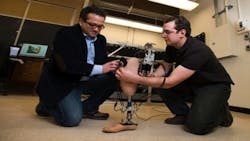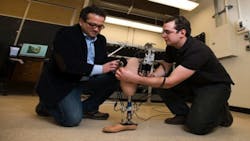Prosthetic Ankle “Sees” the Next Step It Will Take
Robotic prosthetic ankles are under development at a number of laboratories, but Michigan Technological University scientists are doing something they believe is different: giving the ankle “eyes” that will help the ankle navigate the terrain it will walk on.
The ankle, under development by Michigan Technological University mechanical engineer Mo Rastgaar, already offers a range of motion that rivals a natural gait. The scientists have developed an artificial vision system based on a low-cost camera and computer controlled actuator, which adjusts the ankle’s position through a system of cables.
“The camera can identify the profile of the ground, while the computer knows where the next footstep will be, based on how the user is moving the leg,” said Rastgaar. “Then, the computer analyzes the information from the camera and applies the correct angle and stiffness to the ankle, just as you would with your biological foot and ankle.” According to Rastgaar, this would enable the ankle to adapt to the surface, whether it is stairs or a pothole.
Rastgaar’s team has also refined the actuator’s design, making it lighter and more streamlined. Because the foot is moved by lines similar to bicycle brake cables, the actuator does not have to be mounted on the prosthesis, where the user must to move it with every step. Instead, it could be carried in a pocket or fanny pack, for example.
“Also, this new actuator system will be easy to remove, so you can use it or not, based on your needs,” Rastgaar says. “If the user is going to stay at home, it might be simpler to walk around the house with a passive prosthesis.”
Rastgaar hopes the robotic ankle will eventually find its way out of the lab and onto the sidewalk. “One of these days, we hope this can be brought to market, where it could really help people.”
The research is being partially supported by a five-year Faculty Early Career Development (CAREER) Award from the National Science Foundation (NSF), and a provisional patent has been issued for the technology. In addition to Rastgaar, researchers involved in advancing the project include Nina Mahmoudian, an assistant professor of mechanical engineering-engineering mechanics at Michigan Tech; PhD candidate Evandro Ficanha; PhD student Guilherme Ribeiro; Kenton R. Kaufman, professor and director of the Biomechanics/Motion Analysis Laboratory at the Mayo Clinic; and Neville Hogan, professor and director of Newman Laboratory for Biomechanics and Human Rehabilitation at MIT.
About the Author
Spencer Chin
Managing Editor
Spencer Chin is the Managing Editor for Power Electronics Technology. Spencer’s extensive experience in high technology industry publications includes stints with NASA Tech Briefs, EE Times, EBN, and Electronic Products.

